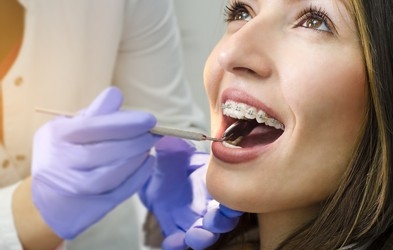Braces – A Beginner’s Guide to Orthodontic Treatment

What Is Orthodontic Treatment?
Orthodontic treatment is a dental procedure that helps in restoring misaligned teeth and jaws or tooth / jaw aligning procedure.
It diagnoses and treats malocclusions, i.e., misaligned bite patterns with the help of various appliances.
Types of Orthodontic Appliances
The most commonly used appliances for this treatment are mentioned below:
Ø Braces:
These consist of brackets, wires, and other components that work together to move teeth into their proper position.
Ø Retainers:
These are used to retain the results of orthodontic treatment. They help in maintaining the teeth in their desired position post-treatment.
Ø Headgear:
These are worn at night with other appliances.
Ø Palate expanders:
These are used for widening a child’s upper jaw in some cases to create extra space without the need for tooth extraction.
WHY GET BRACES?
Some of the most common reasons for choosing to wear braces are:
Ø Crowded or crooked teeth
Ø Overbite or underbite
Ø Crossbite
Ø Gaps between teeth
Ø Jaw misalignment
Braces can help improve teeth and jaw alignment, making it easier for maintaining oral hygiene and reducing the risk of dental problems such as gum disease, cavities, and tooth decay.
It not only enhances the appearance of your smile but also improves chewing and speech function.
How Braces Work?
Braces work by applying constant pressure to the teeth and jaws to gradually move them into a proper position.
There is a membrane beneath the gums surrounded by bones that root our teeth to the jaw. It manages the placement of our teeth and reacts to the pressure exerted by braces.
Though you can get braces at any age, the best time is between the age of 9 to 14 since the facial bones at this age are still developing and much more flexible.
Types of Braces
There are different types of braces available today and the orthodontist can help determine which option to choose depending on specific needs and preferences. Some widely used braces are as follows:
Ø Traditional braces:
These are the most frequently used of all braces. They can be easily noticed and consist of metal brackets and wires that are adjusted over time to gradually move teeth into their proper position.
Ø Ceramic braces:
These are clear braces that work like metal braces. The brackets are made of tooth-colored ceramic material, making them less noticeable.
Ø Lingual braces:
These are similar to the conventional braces, but are placed on the back of the teeth, making them completely concealed.
Ø Clear aligners:
Also called “invisible braces,” clear aligners are used instead of brackets and wires.
These are a series of custom-made removable plastic trays where each set can be used for one or two weeks before switching to the other.
These aligners are made to fit over the teeth to progressively move them to the intended alignment.
What to Expect When Getting Braces
Getting braces typically involves several steps, including:
Consultation:
The orthodontist will discuss your dental history and concerns and then evaluate your teeth and jaws to determine the best treatment plan for you.
X-rays of the whole mouth will be taken to assess the spacing between teeth.
Braces placement:
Prior to the placement of braces the teeth are cleaned, polished, air dried and primed. To ensure visibility throughout the process a cheek retractor is used.
The brackets are then attached to the teeth using dental cement. Then the dental arch wires are threaded through the brackets.
The entire placement process takes about 30 minutes if there is no other complication.
Adjustments:
A visit to the orthodontist every few weeks is required to evaluate the progress in repositioning teeth.
During the visits, the wires are tightened to keep the right amount of pressure needed for teeth to move.
Braces removal:
The braces will come off, and a special tool called a retainer will help keep the teeth in the right position.
POST-TREATMENT CARE
Some patients may experience gum inflammation and discomfort post the placement procedure.
However, the same subsides within a few days. The extra care needed when brushing and flossing after wearing braces is taking extra care.
Removal of all food particles and plaque is necessary. Avoiding certain food such as hard or sticky candies is advisable to prevent damage to the braces.
LET YOUR ORTHODONTICS SET YOUR PERFECT SMILE!
Good positioning of teeth is very important for overall oral health and appearance.
Park Dental Clinic, Dwarka Sec-7, Delhi provides the best orthodontists who are experts in addressing all your dental issues and providing comprehensive treatment.
Several client reviews confirm their treatment satisfaction and value for money. So, without further apprehensions about braces, get them here and flaunt a smile.



